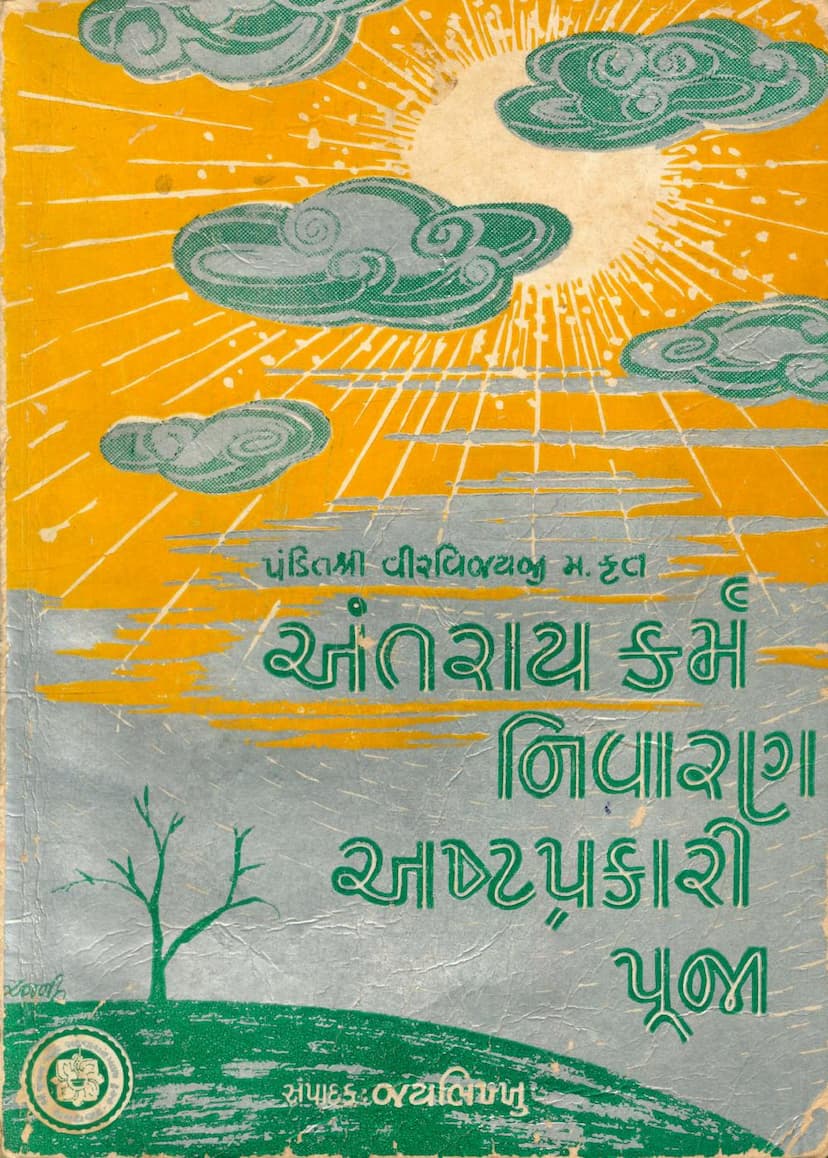Antraykarm Nivaran Ashtaprakari Pooja
Added to library: September 1, 2025

Summary
Here's a comprehensive summary of the Jain text "Antraykarm Nivaran Ashtaprakari Pooja" by Jaybhikkhu, based on the provided Gujarati text:
Book Title: Antraykarm Nivaran Ashtaprakari Pooja (Eightfold Puja for the Removal of Obstruction Karma)
Author: Jaybhikkhu (as editor/compiler), with the original puja composed by Pandit Shri Virvijayji M.
Publisher: Shri Jivanmani Sadvachan Mala Trust, Ahmedabad.
Overview:
This book is a compilation and presentation of an "Eightfold Puja" (Ashtaprakari Pooja) composed by the renowned Jain scholar and poet, Pandit Shri Virvijayji M. (under the pen name "Shubhveer"). The primary purpose of this puja is to eradicate "Antaray Karma" (Obstruction Karma), which is one of the eight types of karma in Jainism that impedes the soul's progress towards liberation. The book is dedicated to the memory of Smt. Lilavatiben Lalbhai Shah, wife of the editor and a devoted follower of Jain principles.
Key Themes and Content:
-
Purpose of the Puja: The central theme is the removal of Antaray Karma. Antaray Karma is explained as the force that obstructs the soul from experiencing its inherent qualities and performing virtuous actions. It is described as an invisible barrier that prevents one from giving, benefiting, enjoying, or exerting one's energy effectively.
-
Eight Types of Karma (Ashtakarma): The book implicitly and explicitly discusses the eight karmas as the fundamental mechanism of the soul's bondage in Jain philosophy. The puja is specifically tailored to address the Antaray Karma, but the introductory sections also touch upon the nature of other karmas:
- Gnanavarniya Karma: Obscures knowledge.
- Darshanavarniya Karma: Obscures perception/faith.
- Vedaniya Karma: Causes feelings of pleasure and pain.
- Mohaniya Karma: Causes delusion and attachment/aversion.
- Ayushya Karma: Determines lifespan and rebirth destination.
- Nama Karma: Determines physical form and attributes.
- Gotra Karma: Determines social standing and lineage.
- Antaray Karma: Obstruction karma (the focus of the puja).
-
The Concept of Karma: The text emphasizes the Jain doctrine of karma, explaining that karma is the driving force behind the cycle of birth and death (samsara). It is through one's own actions (karnani) that karma is accumulated, and through specific practices, karma can be shed. The analogy of gold in a mine being purified is used to illustrate how the soul, though inherently pure, is obscured by karmic matter.
-
The Structure of the Puja: The book presents an eight-part puja, with each part dedicated to purifying the soul through devotional worship using specific substances. Each part begins with a Doha (couplet) explaining its purpose and then proceeds with a "Dhal" (a poetic narrative or devotional song) that illustrates the concept with stories and examples, often from Jain scriptures or traditions. The eight pujas are:
- Jal Puja (Water Puja): To purify and cleanse the soul.
- Chandan Puja (Sandalwood Puja): To achieve inner coolness and remove the obstruction to giving (Danaantaray).
- Pushpa Puja (Flower Puja): To remove the obstruction to profit/gain (Labhantaray) and attain spiritual fragrance.
- Dhoop Puja (Incense Puja): To burn away obstructions to enjoyment and possession (Bhogantaray).
- Deepak Puja (Lamp Puja): To remove obstructions to consumption/utilization (Upabhogantaray) and provide inner light.
- Akshat Puja (Unbroken Rice Puja): To remove obstructions to strength/vigor (Viryantaray) and attain unbroken spiritual power.
- Naivedya Puja (Offering Puja): To overcome the obstruction to sustenance and attain the state of being devoid of food (Nirhari).
- Phal Puja (Fruit Puja): To remove all karmic obstructions and attain the fruit of liberation.
-
Illustrative Stories and Examples: A significant portion of the book consists of compelling narratives and anecdotes that explain the concept of Antaray Karma and the significance of each puja. These stories often feature characters from Jain history and mythology, illustrating how specific actions in past lives led to the accumulation of Antaray Karma and how devotion and virtuous actions can mitigate or remove it. Examples include:
- The story of Kapilā, who obstructed a monk from receiving charity, leading to her downfall.
- The story of King Shrenik and the miserly Kapila.
- The tale of Bhimasen and the obstructions faced due to past life actions.
- The story of Anjana Sundari, Sita, and Damayanti, highlighting separation and loss as consequences of karmic effects.
- The illustration of Mamman Seth, a rich miser, and the consequences of his stinginess.
- The story of the parrots (Shuk and Shukki) who attained a better rebirth through offering fruits.
- The tale of King Vikrama (1874 AD) and the auspicious occasion of the puja's composition.
-
Biographical Information of Pandit Shri Virvijayji M.: The book includes a detailed biography of Pandit Shri Virvijayji M., highlighting his life, his spiritual journey, his conversion to Jainism, and his prolific literary output. He is described as a prominent poet, hymnist, and composer of devotional songs in the 19th century, often referred to as the "Dayaram of his era." His lineage and gurus are also traced, connecting him to the great Jain Acharyas.
-
Editorial Notes and Acknowledgements: The editor, Jaybhikkhu, expresses his gratitude to various individuals and institutions that contributed to the book's publication. He also apologizes for any shortcomings due to the haste of production.
-
Jain Philosophy and Principles: The book serves as a practical guide for devotees to understand and overcome karmic obstructions through devotional practices. It reinforces core Jain principles like the law of karma, the path to liberation (moksha), the importance of virtuous conduct, and the power of devotion.
Significance:
This text is valuable for Jain practitioners seeking to understand and actively combat the effects of Antaray Karma. It provides a structured devotional framework, enriched with theological explanations and inspiring narratives, to aid in spiritual purification and progress towards liberation. The meticulous detail in the puja descriptions and the historical context provided by the author's notes make it a significant text for understanding Jain devotional practices.